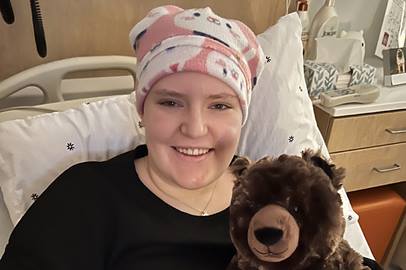Name: Maggie
Condition(s):
- Aplastic Anemia
Specialty(s):
Age at Treatment: 18
Age Today: 22 Years
Meet Maggie
Upon graduating high school in 2022, 18-year-old Maggie noticed lots of small red dots on her legs. When the dots didn’t go away on their own, Maggie scheduled an appointment with her primary care physician. Her doctor recognized the dots as petechiae, small red or purple spots that appear on the skin due to bleeding under the skin. They are typically found on the legs, and feet and are caused by broken blood vessels.
There are various causes of petechiae, but in Maggie’s case, it was a sign of a low platelet count. When a blood vessel is injured, platelets start to clump together at the site of injury, forming a plug that helps to stop bleeding. The normal range of platelet count is 150,000-400,000. Maggie’s count was 25,000.
Though unsure of the cause of her low platelet count, Maggie was determined not to be slowed down by her health issues. She decided to begin her freshman year of college at Miami University on schedule. “Twice a week, I had to walk to the hospital close to campus to get labs done and once a week to get platelet counts,” remembers Maggie. “Navigating the large campus was challenging when I had such low energy from the platelet deficiency.”
Eventually doctors diagnosed Maggie with severe aplastic anemia (SAA), a rare but serious blood disorder resulting from bone marrow failure leading to a decrease in the production of red blood cells, white blood cells, and platelets. The curative treatment for SAA is bone marrow transplant (BMT), which brought her to Nationwide Children's Hospital.
Upon admission, Maggie began chemotherapy, a standard treatment before BMT. After a week of chemotherapy, Maggie was infused with donor stem cells to kickstart her bone marrow factory to produce blood cells. “I had to stay impatient until my immune system built itself back up,” Maggie shares. “I was there for less than a month, which is better than I expected!”
Returning home was a relief for Maggie and her parents who stayed with their daughter her entire inpatient stay. Reunited with her beloved cat Murphy, Maggie was on the road to recovery when she began struggling with graft-versus-host disease (GvHD), a complication that can occur after BMT. It happens when the newly transplanted donor cells (the graft) recognize the recipient's body (the host) as foreign and attack it. She needed steroids to treat GvHD and she responded to this treatment, though she did have side effects in the form of high blood pressure and weight gain.
Although she had chemotherapy, a bone marrow transplant, and GVHD under her belt, Maggie had one last hurdle. “For a long time after my transplant, my new marrow didn't want to produce red blood cells. I was getting blood transfusions weekly for a while,” says Maggie. She was then started on another medication to help her bone marrow produce red cells and “just in the past month, it's gotten so much better! It's going up by itself!”.
As of today, Maggie’s blood type has officially changed to her donor’s. Previously O positive, Maggie now has type A positive.
“My life is almost back to normal!” says Maggie. Back in school, Maggie attends online classes through Columbus State Community College. She wrapped up the fall semester with all A’s. In her free time Maggie likes to go on drives, read books, and spend time with her family, including Murphy.
“A year ago, I barely got out of bed due to a lack of energy,” Maggie remembers. “But now I'm only in bed to sleep at night and try to stay active during the day. I feel eternally blessed to be alive. I view each day as a gift and my family as the most important thing.”




